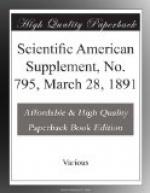In recording my investigations on the subject of radiant matter and the state of gaseous residues in high vacua under electrical strain, I must refer to certain attacks on the views I have propounded. The most important of these questionings are contained in a volume of “Physical Memoirs,” selected and translated from foreign sources under the direction of the Physical Society (vol. i., part 2). This volume contains two memoirs, one by Hittorff on the “Conduction of Electricity in Gases,” and the other by Puluj on “Radiant Electrode Matter and the So-called Fourth State.” Dr. Puluj’s paper concerns me most, as the author has set himself vigorously to the task of opposing my conclusions. Apart from my desire to keep controversial matter out of an address of this sort, time would not permit me to discuss the points raised by my critic; I will, therefore, only observe in passing that Dr. Puluj has no authority for linking my theory of a fourth state of matter with the highly transcendental doctrine of four dimensional space.
Reference has already been made to the mistaken supposition that I have pronounced the thickness of the dark space in a highly exhausted tube through which an induction spark is passed to be identical with the natural mean free path of the molecules of gas at that exhaustion. I could quote numerous passages from my writings to show that what I meant and said was the mean free path as amplified and modified by the electrification.[2] In this view I am supported by Prof. Schuster,[3] who, in a passage quoted below, distinctly admits that the mean free path of an electrified molecule may differ from that of one in its ordinary state.
[Footnote 2: “The thickness of the dark space surrounding the negative pole is the measure of the mean length of the path of the gaseous molecules between successive collisions. The electrified molecules are projected from the negative pole with enormous velocity, varying, however, with the degree of exhaustion and intensity of the induction current.”—Phil. Trans., part i., 1879, par. 530.
“The extra velocity with which the molecules rebound from the excited negative pole keeps back the more slowly moving molecules which are advancing toward the pole. The conflict occurs at the boundary of the dark space, where the luminous margin bears witness to the energy of the discharge.”—Phil. Trans., part i., 1879, par. 507.
“Here, then, we see the induction spark actually illuminating the lines of molecular pressure caused by the excitement of the negative pole.”—R.I. Lecture, Friday, April 4, 1879.
“The electrically excited negative pole supplies the force majeure, which entirely, or partially, changes into a rectilinear action the irregular vibration in all directions.”—Proc. Roy. Soc., 1880. page 472.
“It is also probable that the absolute velocity of the molecules is increased so as to make the mean velocity with which they leave the negative pole greater than that of ordinary gaseous molecules.”—Phil. Trans., part ii., 1881, par. 719.]




